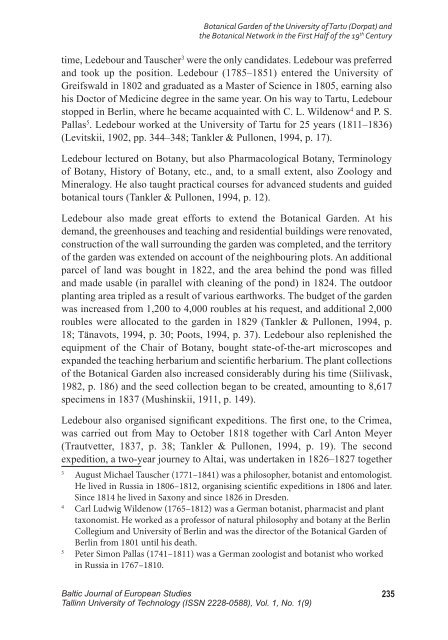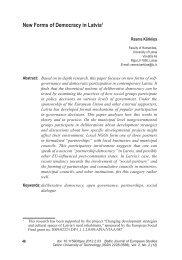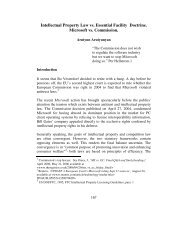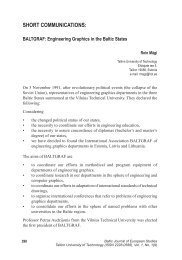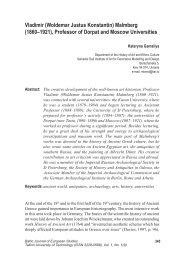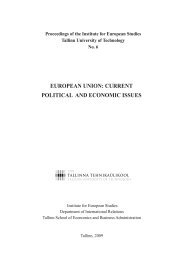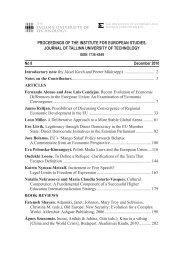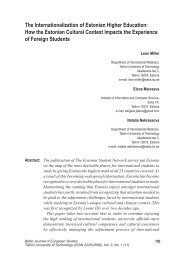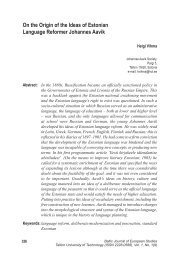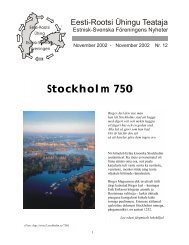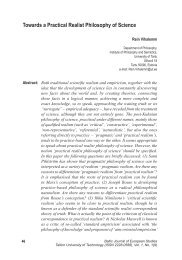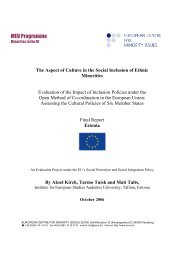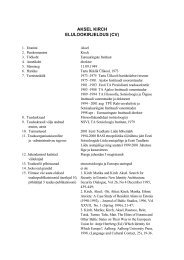Botanical Garden of the university of tartu (dorpat) - The Institute for ...
Botanical Garden of the university of tartu (dorpat) - The Institute for ...
Botanical Garden of the university of tartu (dorpat) - The Institute for ...
Create successful ePaper yourself
Turn your PDF publications into a flip-book with our unique Google optimized e-Paper software.
<strong>Botanical</strong> <strong>Garden</strong> <strong>of</strong> <strong>the</strong> University <strong>of</strong> Tartu (Dorpat) and<br />
<strong>the</strong> <strong>Botanical</strong> Network in <strong>the</strong> First Half <strong>of</strong> <strong>the</strong> 19 th Century<br />
time, Ledebour and Tauscher 3 were <strong>the</strong> only candidates. Ledebour was preferred<br />
and took up <strong>the</strong> position. Ledebour (1785–1851) entered <strong>the</strong> University <strong>of</strong><br />
Greifswald in 1802 and graduated as a Master <strong>of</strong> Science in 1805, earning also<br />
his Doctor <strong>of</strong> Medicine degree in <strong>the</strong> same year. On his way to Tartu, Ledebour<br />
stopped in Berlin, where he became acquainted with C. L. Wildenow 4 and P. S.<br />
Pallas 5 . Ledebour worked at <strong>the</strong> University <strong>of</strong> Tartu <strong>for</strong> 25 years (1811–1836)<br />
(Levitskii, 1902, pp. 344–348; Tankler & Pullonen, 1994, p. 17).<br />
Ledebour lectured on Botany, but also Pharmacological Botany, Terminology<br />
<strong>of</strong> Botany, History <strong>of</strong> Botany, etc., and, to a small extent, also Zoology and<br />
Mineralogy. He also taught practical courses <strong>for</strong> advanced students and guided<br />
botanical tours (Tankler & Pullonen, 1994, p. 12).<br />
Ledebour also made great ef<strong>for</strong>ts to extend <strong>the</strong> <strong>Botanical</strong> <strong>Garden</strong>. At his<br />
demand, <strong>the</strong> greenhouses and teaching and residential buildings were renovated,<br />
construction <strong>of</strong> <strong>the</strong> wall surrounding <strong>the</strong> garden was completed, and <strong>the</strong> territory<br />
<strong>of</strong> <strong>the</strong> garden was extended on account <strong>of</strong> <strong>the</strong> neighbouring plots. An additional<br />
parcel <strong>of</strong> land was bought in 1822, and <strong>the</strong> area behind <strong>the</strong> pond was filled<br />
and made usable (in parallel with cleaning <strong>of</strong> <strong>the</strong> pond) in 1824. <strong>The</strong> outdoor<br />
planting area tripled as a result <strong>of</strong> various earthworks. <strong>The</strong> budget <strong>of</strong> <strong>the</strong> garden<br />
was increased from 1,200 to 4,000 roubles at his request, and additional 2,000<br />
roubles were allocated to <strong>the</strong> garden in 1829 (Tankler & Pullonen, 1994, p.<br />
18; Tänavots, 1994, p. 30; Poots, 1994, p. 37). Ledebour also replenished <strong>the</strong><br />
equipment <strong>of</strong> <strong>the</strong> Chair <strong>of</strong> Botany, bought state-<strong>of</strong>-<strong>the</strong>-art microscopes and<br />
expanded <strong>the</strong> teaching herbarium and scientific herbarium. <strong>The</strong> plant collections<br />
<strong>of</strong> <strong>the</strong> <strong>Botanical</strong> <strong>Garden</strong> also increased considerably during his time (Siilivask,<br />
1982, p. 186) and <strong>the</strong> seed collection began to be created, amounting to 8,617<br />
specimens in 1837 (Mushinskii, 1911, p. 149).<br />
Ledebour also organised significant expeditions. <strong>The</strong> first one, to <strong>the</strong> Crimea,<br />
was carried out from May to October 1818 toge<strong>the</strong>r with Carl Anton Meyer<br />
(Trautvetter, 1837, p. 38; Tankler & Pullonen, 1994, p. 19). <strong>The</strong> second<br />
expedition, a two-year journey to Altai, was undertaken in 1826–1827 toge<strong>the</strong>r<br />
3<br />
August Michael Tauscher (1771–1841) was a philosopher, botanist and entomologist.<br />
He lived in Russia in 1806–1812, organising scientific expeditions in 1806 and later.<br />
Since 1814 he lived in Saxony and since 1826 in Dresden.<br />
4<br />
Carl Ludwig Wildenow (1765–1812) was a German botanist, pharmacist and plant<br />
taxonomist. He worked as a pr<strong>of</strong>essor <strong>of</strong> natural philosophy and botany at <strong>the</strong> Berlin<br />
Collegium and University <strong>of</strong> Berlin and was <strong>the</strong> director <strong>of</strong> <strong>the</strong> <strong>Botanical</strong> <strong>Garden</strong> <strong>of</strong><br />
Berlin from 1801 until his death.<br />
5<br />
Peter Simon Pallas (1741–1811) was a German zoologist and botanist who worked<br />
in Russia in 1767–1810.<br />
Baltic Journal <strong>of</strong> European Studies<br />
Tallinn University <strong>of</strong> Technology (ISSN 2228-0588), Vol. 1, No. 1(9)<br />
235


